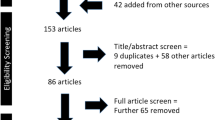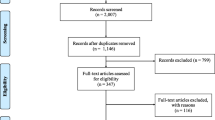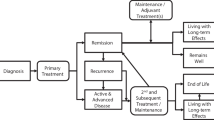Abstract
Purpose
The objective of this study is to document the prevalence of traditional, complementary, and alternative medicine (TCAM) use by adult cancer patients at a national teaching hospital in Malawi. We aim to document the products/therapies used, the reason for use, as well as patient-reported satisfaction with TCAM practitioners and modalities.
Methods
We conducted investigator-administered interviews with adult cancer patients presenting to the Kamuzu Central Hospital (KCH) Cancer Clinic in Lilongwe, Malawi between January and July 2018. The KCH is a national teaching hospital in the capital of Lilongwe, which serves patients with cancer from the northern half of Malawi. Descriptive statistics were used to describe TCAM use and logistic regression was applied to identify predictors of TCAM.
Results
A total of 263 participants completed the survey, of which 70% (n = 183) were female and average age was 45 (SD 14) years old. The prevalence of overall TCAM use was 84% (n = 222), and 60% (n = 157) of participants reported combining TCAM with conventional cancer treatment. The majority of patients used TCAM to directly treat their cancer versus for symptom management. Patients reported using faith-based healing (64%, n = 168), herbal medicine (56%, n = 148), diet change (46%, n = 120), and vitamins/minerals (23%, n = 61). Participants reported the highest satisfaction for physicians among practitioners and diet change for modalities. Female gender was found to be a predictor of TCAM with conventional treatment use, no other significant predictors were observed.
Conclusion
There is a high prevalence of TCAM use among an adult population with cancer in Malawi, and a wide variety in the TCAM modalities used among patients. Additional studies are needed to identify risks and benefits of TCAM use to assist with policy and public health, patient safety, and holistically address the global burden of cancer.
Similar content being viewed by others
Data availability
See supplemental data files for survey materials used for this study.
References
Global Cancer Observatory (n.d.) http://gco.iarc.fr/ . Accessed 28 Jan 2020
Cancer. World Health Organization 2018. https://www.who.int/news-room/fact-sheets/detail/cancer . Accessed 28 Jan 2020
World Health Organization WHO Cancer Factsheet 2018. http://www.who.int/mediacentre/factsheets/fs297/en/ Accessed 20 Dec 2016
Stewart B, Wild C (2014) World Health Organization World Cancer Report 2014
World Health Organization (2000) General guidelines for methodologies on research and evaluation of traditional medicine. World Health Organization, Geneva
Mureyi DD, Monera TG, Maponga CC (2012) Prevalence and patterns of prenatal use of traditional medicine among women at selected harare clinics: a cross-sectional study. BMC Complement Altern Med. https://doi.org/10.1186/1472-6882-12-164
Kpobi L, Swartz L (2018) ‘That is how the real mad people behave’: beliefs about and treatment of mental disorders by traditional medicine-men in Accra, Ghana. Int J Soc Psychiatry 64:309–316. https://doi.org/10.1177/0020764018763705
Lunyera J, Wang D, Maro V, Karia F, Boyd D, Omolo J et al (2016) Traditional medicine practices among community members with diabetes mellitus in Northern Tanzania: an ethnomedical survey. BMC Complement Altern Med. https://doi.org/10.1186/s12906-016-1262-2
Stanifer JW, Patel UD, Karia F, Thielman N, Maro V, Shimbi D et al (2015) The determinants of traditional medicine use in northern Tanzania: a mixed-methods study. PLoS ONE 10:e0122638. https://doi.org/10.1371/journal.pone.0122638
Hill J, Mills C, Li Q, Smith JS (2019) Prevalence of traditional, complementary, and alternative medicine use by cancer patients in low income and lower-middle income countries. Glob Public Health 14:418–430. https://doi.org/10.1080/17441692.2018.1534254
Bodeker G, Kronenberg F (2002) A public health agenda for traditional, complementary, and alternative medicine. Am J Public Health 92:1582–1591
Bannerman R, Burton J, Chien W (1993) Traditional medicine and healthcare coverage. World Health Organization, Geneva
World Health Organization (2002) WHO traditional medicine strategy 2002–2005. WHO Traditional Medicine Strategy World Health Organization, Geneva
World Health Organization (2013) WHO traditional medicine strategy 2014–2023. World Health Organization, Geneva
James PB, Wardle J, Steel A, Adams J (2018) Traditional, complementary and alternative medicine use in Sub-Saharan Africa: a systematic review. BMJ Glob Health 3:895. https://doi.org/10.1136/bmjgh-2018-000895
John GM, Hershman DL, Falci L, Shi Z, Tsai WY, Greenlee H (2016) Complementary and alternative medicine use among US cancer survivors. J Cancer Surviv 10:850–864. https://doi.org/10.1007/s11764-016-0530-y
Wode K, Henriksson R, Sharp L, Stoltenberg A, Hök NJ (2019) Cancer patients’ use of complementary and alternative medicine in Sweden: a cross-sectional study. BMC Complement Altern Med 19:62. https://doi.org/10.1186/s12906-019-2452-5
Berretta M, Della Pepa C, Tralongo P, Fulvi A, Martellotta F, Lleshi A et al (2017) Use of complementary and alternative medicine (CAM) in cancer patients: an Italian multicenter survey. Oncotarget 8:24401–24414. https://doi.org/10.18632/oncotarget.14224
Block KI, Gyllenhaal C (2002) Clinical corner: herb-drug interactions in cancer chemotherapy: theoretical concerns regarding drug metabolizing enzymes. Integr Cancer Ther 1:83–89. https://doi.org/10.1177/1534735402001001007
Davis EL, Oh B, Butow PN, Mullan BA, Clarke S (2012) Cancer patient disclosure and patient-doctor communication of complementary and alternative medicine use: a systematic review. Oncologist 17:1475–1481. https://doi.org/10.1634/theoncologist.2012-0223
Obrist M, Osei-Bonsu E, Awuah B, Watanabe-Galloway S, Merajver SD, Schmid K et al (2014) Factors related to incomplete treatment of breast cancer in Kumasi, Ghana. Breast 23:821–828. https://doi.org/10.1016/j.breast.2014.08.014
Dunyo SK, Ahorlu CK, Simonsen PE (1997) Scarification as a risk factor for rapid progression of filarial elephantiasis. Trans R Soc Trop Med Hyg 91:446
Letsyo E, Jerz G, Winterhalter P, Beuerle T (2017) Toxic pyrrolizidine alkaloids in herbal medicines commonly used in Ghana. J Ethnopharmacol 202:154–161. https://doi.org/10.1016/J.JEP.2017.03.008
Hill J, Seguin R, Phanga T, Manda A, Chikasema M, Gopal S et al (2019) Facilitators and barriers to traditional medicine use among cancer patients in Malawi. PLoS ONE. https://doi.org/10.1371/journal.pone.0223853
Quandt SA, Verhoef MJ, Arcury TA, Lewith GT, Steinsbekk A, Kristoffersen AE et al (2009) Development of an international questionnaire to measure use of complementary and alternative medicine (I-CAM-Q). J Altern Complement Med (New York, NY) 15:331–339. https://doi.org/10.1089/acm.2008.0521
Erku DA (2016) Complementary and alternative medicine use and its association with quality of life among cancer patients receiving chemotherapy in Ethiopia: a cross-sectional study. Evid-Based Complement Altern Med 2016:1–8. https://doi.org/10.1155/2016/2809875
Ezeome ER, Anarado AN (2007) Use of complementary and alternative medicine by cancer patients at the University of Nigeria Teaching Hospital, Enugu, Nigeria. BMC Complement Altern Med 7:28. https://doi.org/10.1186/1472-6882-7-28
Alexander GA (1982) A survey of traditional medical practices used for the treatment of malignant tumors in an East African population. Soc Sci Med 1985(20):53–59
Kayombo EJ, Uiso FC, Mbwambo ZH, Mahunnah RL, Moshi MJ, Mgonda YH (2007) Experience of initiating collaboration of traditional healers in managing HIV and AIDS in Tanzania. J Ethnobiol Ethnomed 3:6. https://doi.org/10.1186/1746-4269-3-6
Msyamboza KP, Phiri T, Sichali W, Kwenda W, Kachale F (2011) Cervical cancer screening uptake and challenges in Malawi from 2011 to 2015: Retrospective cohort study. BMC Public Health 2016:16. https://doi.org/10.1186/s12889-016-3530-y
Pfaff C, Singano V, Akello H, Amberbir A, Berman J, Kwekwesa A et al (2018) Early experiences in integrating cervical cancer screening and treatment into HIV services in Zombacentral hospital, Malawi. Malawi Med J 30:211–214. https://doi.org/10.4314/mmj.v30i3.14
Rohner E, Kasaro M, Msadabwe-Chikuni SC, Stinson K, Mohamed Z, Tweya H et al (2017) Treatment and outcome of AIDS-related Kaposi sarcoma in South Africa, Malawi and Zambia: an international comparison. Pan Afr Med J 28:261. https://doi.org/10.11604/pamj.2017.28.261.11300
Shumay DM, Maskarinec G, Gotay CC, Heiby EM, Kakai H (2002) Determinants of the degree of complementary and alternative medicine use among patients with cancer. J Altern Complement Med 8:661–671. https://doi.org/10.1089/107555302320825183
Gross AM, Liu Q, Bauer-Wu S (2007) Prevalence and predictors of complementary therapy use in advanced-stage breast cancer patients. J Oncol Pract 3:292–295. https://doi.org/10.1200/jop.0762001
Funding
University of North Carolina, Chapel Hill, Lineberger Comprehensive Cancer Center Tier 1 Pilot Development Award. The Research Fellowship in Complementary and Integrative Health (5T32AT003378-12) from the National Center for Complementary and Integrative Health provided salary support for Dr. Hill.
Author information
Authors and Affiliations
Corresponding author
Ethics declarations
Conflict of interest
The authors have no conflict of interest to disclose.
Disclaimer
This work was completed while Dr. Satish Gopal was employed at the University of North Carolina at Chapel Hill. The opinions expressed in this article are the authors own and do not reflect the view of the National Institutes of Health, the Department of Health and Human Services, or the United States Government.
Ethical approval
This study has been approved by the University of North Carolina Institutional Review Board (Protocol #17-0933) as well as the National Health Science Research Committee of Malawi (Protocol #21711).
Consent for participation
All study participants provided written informed consent for participation.
Consent for publication
Consent for publication was included in the written informed consent signed by each participation.
Additional information
Publisher's Note
Springer Nature remains neutral with regard to jurisdictional claims in published maps and institutional affiliations.
Supplementary Information
Below is the link to the electronic supplementary material.
Rights and permissions
About this article
Cite this article
Hill, J., Seguin, R., Manda, A. et al. Prevalence of traditional, complementary, and alternative medicine (TCAM) among adult cancer patients in Malawi. Cancer Causes Control 33, 1047–1057 (2022). https://doi.org/10.1007/s10552-022-01563-0
Received:
Accepted:
Published:
Issue Date:
DOI: https://doi.org/10.1007/s10552-022-01563-0




